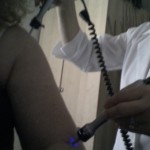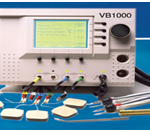Find Out What MicroCurrent Color Therapy is All About and How it Can Help Transform Your Life!
- Relief from acute & chronic pain with or without needles
- Acceleration of tissue healing for faster rehabilitation after injuries or surgery
- Soul healing & emotional balancing
- Used in the treatment of Facial Rejuvenation for Anti-Aging
I invite you to experience the powerful effects offered at a promotional price of $30. Regularly $100 per treatment or $75 with a Healthy Roads, OptumHealth, or Affinity 25% discount.

Marathon Week August 27-31
No insurance please. Bring a friend or family member with you to have treatment at the same time! Regular price per session for non-needle MicroCurrent Electro-Acupuncture is $100 (or $75 if you are eligible for a 25% off discount through your health insurance plan).
You will be saving $35 or even up to $60 on for MicroCurrent Color Therapy!
Micro-Current Marathon
For the week of August 27 to the 31st pay only $30 per visit for this service.
All appointments are for Micro-Current only. No insurance please.
Our goal at Acupuncture Center, Inc. is for you to be able to receive care regularly enough and long enough to get better and stay healthy while experiencing even deeper and lasting results with MicroCurrent Color Electro-Acupuncture. Treatment can be done without the use of needles. Fear of needles does not have to stop you from benefiting from this powerful medicine.

Non-Needle MicroCurrent Electro-Acupuncture can dramatically improve the acupuncture effect and shorten treatment times! Therefore, those needle phobes can not use the excuse, “I’m afraid of needles!” There is no reason not to give it a try! This can often be combined with acupuncture needling depending on patient needs. The specialized Acutron Mentor device delivers gentle electrical pusles with color light frequencies that help stimulate the body’s own natural healing resources.
About Microcurrent and Light Therapies: From Darren Starwynn, http://www.eastwestmed.com/about_microcurrent.php
Electrical energy and light have been used for treating health conditions and pain relief since ancient times. The first use of electrical currents for this purpose has been traced to the ancient Romans who used electrical fish from the Mediterranean Sea to treat gout pain. Even earlier at the eve of the Bronze Age the Chinese used acupuncture needles, which create low electrical discharges when inserted in the body. The ancient Greeks have been known to treat health conditions by bathing patients in filtered light of specific frequencies.
Modern research and technology have allowed the creation of much more precise electro-therapeutic tools. Acceptance of electro-therapy for pain management started in the 1960’s with the development of portable TENS units. Since then, many variations on electrical stimulation have been created, including electric muscle stimulation, interferential, high-volt and microcurrent devices.
FIND OUT WHAT Microcurrent and Light Therapies CAN MEAN IN YOUR LIFE!!
What are people saying about Non-needle MicroCurrent Electro-Acupuncture?
“That tool you have is the best thing on this planet for pain and healing. I was in so much pain when my back went out that I couldn’t move! I can’t believe how much better I feel, and how much easier it is to move after the treatment. I feel much less pain, and more mobility.” Eelia Henderschied.
“I love the acupuncture along with the Acutron MicroCurrent treatments! I can feel the difference in my upper back pain. I also feel more energized.” R. Heimpel.
“It is very cool. Thanks Michele for helping me feel better. I am no longer afraid of acupuncture needles either. The color light therapy has lifted my mood and improved my perspective on life. Thanks again.” Marie Brown
“Thank you Michele! The acupuncture along with the MicroCurrent Color light has saved my life this past week. I was feeling down, and having extreme pain in my hip didn’t help. The treatment helped with both.” Judy Sanders
Combination of Micro-Current and Color Light! Efficacy of treatment results is boosted by selecting colors (wavelengths) of light.
Color Light enhances cellular and organic functioning, ATP production and facilitation of various mind-body healing processes. Color Light Research
Blue for insomnia, pain relief, inflammation, acne;
Purple for Anxiety, pain relief, inflammation, acne;
Green to tone, lift muscles;
Yellow for Anger, to drain lymph;
Violet to Calm, relax;
Red for depression, guilt, PTSD, scars, poor circulation, hypofunction;
Magenta to Boost adrenals/kidney function, balance emotions, infertility;
Orange to Decongest, build thyroid function, lessen guilt;
Red, blue, green, others for Facial Rejuvenation.
What is MicroCurrent Color Light Therapy?
It is a highly effective holistic treatment for pain, anxiety, depression, stress, nausea, and chronic ailments. Similar to traditional acupuncture, while using the exact same system of Chinese Medicine. The Acutron Mentor device delivers gentle electrical pulses with color light frequencies that help restore the healthy flow of Qi (energy) throughout your body, while removing any blockages and clearing out stagnant areas, thus creating a stronger and clearer experience of health and well-being.
Research for micro-current physiology:
| l) Carley and Wainapel: Electrotherapy for Acceleration of Wound Healing: |
| Low Intensity Direct Current Archives of Physical Medicine and Rehabilitation, Vol. 66, July 1985 |
|
Summary: 30 hospital patients with non healing ulcers were divided into two groups, one treated with conventional wound dressings and one with microcurrent stimulation at 300-700 uA. The latter group was given two two hour stimulation periods per day. After six weeks of such treatments, the group treated with microcurrents showed a 150-250% faster healing rate , with stronger scar formation, less pain and lessened infection of the treated area. |
| 2) Wolcott, Wheeler, Hardwicke, and Rowley: |
| Accelerated Healing of Skin Ulcers by Electrotherapy Southern Medical Journal, July 1969. |
|
Summary: These researchers applied microcurrent stimulation ranging from 200-800 uA to a wide variety of wounds, using negative polarity over the lesions in the initial phase, and then alternating positive and negative electrodes every three days. The treated group showed 200-350% faster healing rates than control, with stronger tensile strength of scar tissue and antibacterial effects in infected wounds in the treated group. |
| 3) Gault and Gatens: |
| Use of Low Intensity Direct Current in Management ofIschemic Skin Ulcers Physical Therapy, Vol. 56, #3, March 1976. |
|
Summary: 100 patients with skin ulcers were treated with microcurrent stimulation; six of them had bacterial ulcers with one side used as controls. Stimulation of 200-800 uA was applied, with negative polarity used until infection cleared, and then polarity reversed. Patients had diagnosis ranging from quadriplegia, CVA, brain tumor, peripheral vascular disease, burns, diabetes, fracture, and amputation. The lesions with patients treated with currents showed approximately twice as fast a healing rate. |
| 4) Cheng, et Al: |
| The Effects of Electric Current on ATP Generation, Protein Synthesis, and Membrane Transport in Rat Skin Clinical Orthopaedics and Related Research, #171, Nov/Dec. 1982 |
|
Summary: These researchers used in vitro slices of rat skin to determine some of the biochemical explanations for accelerated wound healing demonstrated in the above studies. By applying various levels of current to the samples, and then chemically analyzing them, they determined that skin treated at currents below 1000 uA showed up to 75% higher amino acids and up to 400% more available ATP than controls, and that skin treated at levels above 1000 uA showed depressed levels of of these substances. Often less than non-treated controls. |
| 5) Rowley, McKenna, and Wolcott:Proceedings: |
| Use of Low Level Electrical Current for Enhancement of Tissue Healing. Biomedical Scientific Instruments #10, 1974 |
| Summary: This article is an overview of theory and research into the titled field. |
| 6) Tomoya Ohno (Japanese): |
| Experimental Studies of Influences on Healing Process of Mandibular Defect Stimulated by Microcurrent Shikwa Gakuho, #82 1982 |
|
Summary: 50 uA microcurrents were applied to one side of the jaws of a group of dogs with lesions in their jaws. The other side was untreated. The dogs were examined at periods of 3, 7, 14, 21, 28, 42 and 56 days. Results: “It seems likely that direct microcurrent promotes normal bone formation within the defective area and accelerates the osseous healing process. Prolonged application of electrical stimulus promotes a remarkable bone remodeling mechanism.” |
| 7) Sinitsyn, Razvozva (Russian): |
| Effects of Electrical Microcurrents on Regeneration Processes in Skin Wounds Ortop Travmatol Protez, Feb. 1986 |
|
Summary: 68 patients with post burn and post traumatic wounds underwent treatment constant and modulated microcurrent of negative polarity of 1-10 uA/cm2 over a period of 2-20 days. Although both groups showed accelerated regeneration, the modulated electric current group showed more prolonged and marked effect. Better survival of skin grafts was demonstrated compared with uintreated patients. |
| 8) Sinitsyn, Razvozova, (Russian): |
| Stimulation of the Regeneration of Skin Wounds by Microcurrents Vopr Juroortol Fizioter Lech Fiz Kult, Nov.-Dec. 1985 |
| 9) Nessler and Mass: |
| Direct-Current Electrical Stimulation of Tendon Healing in Vitro Clinical Orthopedics and Related Research, April 1987 |
|
Summary: 80 tendons from white rabbits were surgically transected and removed from the animals after being surgically repaired. They were divided into 4 groups of 20, and cultured with 10 of each group being electrically stimulated, and half not. A 1.4 volt direct current connected through a 150 kOhm resistor was used for stimulation, at a current of about 7 uA. It was found that currents any higher than this caused discoloration of the tendons. Healing was measured by proline uptake and bridging of the repair site by the epitenon. Results: “a continuous direct current causes increased tendon cell activity within seven days and the increased activity may persist as long as 42 days.” The researchers suggested that externally applied microcurrents may be preferable in future studies. |
| 10) Stanish and Gunlaughson: |
| Electrical Energy and Soft-Tissue Injury Healing Sportcare and Fitness, Sept/Oct 1988 |
|
Summary: This article is a summary of research into tendon healing acceleration, including human injuries of the anterior cruciate ligament and the Achilles tendons: “While the results are subjective, the individuals in both groups appear to have returned to usual activities more quickly, and have greater mobility, than people treated more conventionally”. |
| 11) Vanable, Joseph: |
| The Role of Endogenous Electrical Fields in Limb Regeneration Limb Development and Regeneration, Part A. pages 587-596 Alan Liss Publishing, N.Y. 1983 |
| 12) Oweye, Spielholz and Nelson: |
| Low-intensity Pulsed Galvanic Current and the Healing of Tenotomized Rat Achilles Tendons: Preliminary Report Using Load-to-Breaking Measurements Archives Physical Med Rehab, Vol. 68, July 1987 |
|
Summary: 60 rats were divided into three groups of 20. One was unstimulated, one group had their Achilles tendons stimulated with positive (anodal) current, and the third group’s tendons were stimulated with negative (cathodal) currents. A current of 75 microamps, at 10 Hz was used. Results: “The group treated with anodal current withstood significantly greater loads (p<0.001) than did either the group which healed normally (i.e. without stimulation) or the group treated with cathodal currents”. |
| 13) Reichmanis, Marino, and Becker: |
| Electrical Correlates of Acupuncture Points IEEE Transactions on Biomedical Engineering, November, 1975 |
|
Abstract: Employing a wheatstone bridge, skin conductance was measured over those putative acupuncture points on the large intestine and pericardium meridians lying between the metacarpophalangeal joints and the elbow. Results were compared to those from anatomically similar locations devoid of acupuncture points. “At most acupuncture points on most subjects, there were greater electrical conductance maxims than at control sites”. |
| 14) reported by Lawrence Altman: |
| Cell Channel Finding Earns Nobel Prize New York Times Medical Science section, October, 9, 1991 |
|
Summary: Two German scientists, Dr. Erwin Neher and Dr. Bert Sakmann, will share the $1 million dollar Nobel prize for their development of the patch-clamp technique that allows the detection of minute electrical currents in cell membranes. This discovery, which “revolutionized modern biology” may shed light on the causes of several diseases, like diabetes and cystic fibrosis. This method allowed the detection of 20 to 40 types of ion channels that allow positive or negatively charged ions into and out of the cells. “This study confirmed that electrical activity is not limited to nerve and muscle tissue, as previously thought, but is intrinsic to ‘all kinds of other cells’”. |
| 15) Richez, Chamay and Bieler, U. of Geneva: |
| Bone Changes Due to Pulses of Direct Electric Microcurrent, Virchows Arch. Abt. A Path Anat. 357, 11-18 (1972) |
|
Summary: 26 rabbits had platinum electrodes surgically implanted into the medullary cavities of their humerus bones. Microcurrent stimulation was applied at 50 and 250 uA, allowing pause periods of one second between one second treatment bursts. The scientists found that osteogenesis (bone growth) happened more around the cathode (negative polarity), and that slight tissue necrosis occurred around the anode. The tissues stimulated acted as capacitors, discharging 75% of the current absorbed during the rest periods. They concluded that pulsed current is superior to direct current for bone healing acceleration. |
| 16) J.A. Spadaro, S.E. Chase, and D.A. Webster: |
| Bacterial inhibition by electrical activation of percutaneous silver implants, Journal of Biomedical Materials Research, Vol. 20, 565-577 (1986) |
|
Summary: Percutaneous silver wire implants were placed in rats, and the wounds inoculated with Staphylococcus aureus to test how much infection would spread. Microcurrent stimulation was passed through the wires, with + anodal current placed into implanted silver wire, and the – cathodal electrode placed on the rat’s belly as a ground. It was found that significant inhibition of infection occurred, with the most marked results at 20uA current level. “Metallic silver can be effectively and efficiently activated to elicit its anti-microbial activity by the application of microampere electrical current.” |
| 17) Byl, McKenzie et.al.: |
| Pulsed Microampereage Stimulation: A Controlled Study of Healing of Surgically Induced Wounds in Yucatan Pigs, Physical Therapy, Volume 74, Number 3/March 1994 |
|
Summary: This study failed to confirm the superiority of microcurrent-stimulated wounds in test pigs over controls. A good review of previous studies is given as well as a discussion of which research variables could account for the inconclusive results, which vary from other studies that found microcurrent to be efficacious for wound healing. |
| 18) Bertolucci and Grey: |
| Clinical Comparative Study of Microcurrent Electrical Stimulation to Mid-Laser and Placebo Treatment in Degenerative Joint Disease of the Temporomandibular Joint, Journal of Craniomandibular Practice, 1995 |
|
Summary: 48 patients were divided into three groups, some receiving placebo, some microcurrent and some laser to treat pain of TMJ sydrome. Both microcurrent and laser were found to be significantly more effective than placebo, with laser slightly more effective than microcurrent. The author acknowledges that lasers are not legally sold in the United States for this purpose, and that microcurrent’s easy accessibility makes it more practical for practitioners here. |
| 19) M. Heffernan: |
| Comparative Effects of Microcurrent Stimulation on EEG Spectrum and Correlation Dimension, Integrative and Behavioural Science, July-September, 1996, Vol. 31, #3 |
|
Summary: 30 subjects were selected for a study comparing the effects of microcurrent on smoothing of EEG measurements of the brain. Subjects were randomly assigned to three groups – microcurrent (100uA) applied to earloble, trapezius area of shoulder, and no stimulation. Electrodes were arranged so subjects could not tell which group they were in. Fast Fourier Transform (FFT) and correlation dimension from chaos analysis were used to measure results. The researcher found that microcurrent applied to the shoulders was markedly more effective in smoothing EEG patterns than earlobe or placebo. “This would represent a possible cost-effective alternative to neurofeedback in treating (anxiety and attention deficit disorders), by raising low regions in the FFT. |
| 20) DuPont: |
| Trigger Point Identification and Treatment with Microcurrent, The Journal of Craniomandibular Practice, October 1999, Vol. 17, #4 |
|
Summary: This article gives the author’s techniques for locating and stimulating trigger points (TP’s) using a microcurrent stimulator, specifically for the treatment of temporomandibular disorders. He states that electrical conductivity is highest over trigger points, and galvanic skin response (GSR) testing can be used to locate such points. He utilizes probe electrodes to treat small TP’s, and pad electrodes to treat larger ones. Probe treatment is delivered @ 0.3 Hz, 20 – 40 uA, with treatment time of 10 – 30 seconds per site. He suggests administering treatment in 24-48 intervals, and states that results should be seen within 2 – 3 treatments. He acknowledges that these protocols are not necessarily the best ones, but work well for his practice. 2) Vanable, Joseph: The Role of Endogenous Electrical Fields in Limb Regereration Limb Development and Regeneration, Part A, pgs. 587-596, Alan Liss Publishing, N.Y., 1983 2) Vanable, Joseph: The Role of Endogenous Electrical Fields in Limb Regereration Limb Development and Regeneration, Part A, pgs. 587-596, Alan Liss Publishing, N.Y., 1983 |


